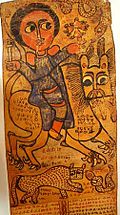Ezana of Axum
| Negus Ezana ዒዛና Ἠεζάνα τῆς Ἀξωμιτῆς | |
|---|---|
 Gold coin of Ezana of Axum | |
| King of Axum | |
| Reign | 320s – c. 360 AD |
| Predecessor | Ousanas |
| Successor | MHDYS |
Ezana (Aizan) | |
|---|---|
| King | |
| Honored in | Catholic Church Ethiopian Orthodox Tewahedo Church |
| Feast | 1 October and 27 October |
| Part of Oriental Orthodoxy |
 |
| Oriental Orthodox churches |
|---|
|
|
Ezana (
then served as regent until he came of age.Reign
Ezana was the first monarch of the Kingdom of Aksum to embrace
Ethiopian Church. A surviving letter from the Arian Roman emperor Constantius II is addressed to ‘Ezana and his brother Saizana and requests that Frumentius be sent to Alexandria to be examined for doctrinal errors and be replaced by Theophilos the Indian; Munro-Hay assumes that ‘Ezana either refused or ignored this request.[4]
Ezana also launched several military campaigns, which he recorded in his inscriptions. A pair of inscriptions on a
Ge'ez found at Meroë is thought of as evidence of a campaign in the fourth century, either during Ezana's reign, or by a predecessor like Ousanas. While some authorities interpret these inscriptions as proof that the Aksumites destroyed the kingdom of Meroë, others say that archaeological evidence points to an economic and political decline in Meroë around 300.[5]
Moreover, some view the stela as military aid from Axum to Meroë to quell the revolt and rebellion by the Nuba. However, conclusive evidence and proof as to which view is correct is not currently available.
On some of the
I, Ezana, King of the Kingdom of Aksum and Himyarites and of Reeidan and of the Ethiopians and of the Sabaites and of Sileel (?) and of Hasa and of the Bougaites and of Taimo...
Ezana is unknown in the King Lists even though the coins bear this name. According to tradition, Emperors Abreha and Asbeha ruled Ethiopia when Christianity was introduced. It may be that these names were later applied to ‘Ezana and his brother or that these were their baptismal names.[12]
Veneration
Along with his brother,
See also
References
- ^ Stuart Munro-Hay (2002). Ethiopia: The Unknown Land. I.B. Tauris. p. 41.
- ISBN 978-1-60239-706-4.)
{{cite book}}: CS1 maint: location missing publisher (link - ^ Munro-Hay, Aksum, p. 77
- ^ Munro-Hay, Aksum, pp. 78ff
- ^ Munro-Hay, Aksum, pp. 79, 224.
- ^ Munro-Hay, Aksum, p. 192.
- ^ Details in Paul B. Henze, Layers of Time: A History of Ethiopia (New York: Palgrave, 2000), p. 31 n.18.
- ^ ISBN 978-1-4412-4571-7.
- ^ .|quote=Moi, Ézana, roi des Axoumites, des Himyarites, de Reeidan, des Sabéens, de S[il]éel, de Kasô, des Bedja et de Tiamô, Bisi Alêne, fils de Elle-Amida et serviteur du Christ
- ISBN 9781108057820.
- ISBN 978-80-268-5034-2.
- ^ See "'Ezana" article on Dictionary of African Christian Biography (http://www.dacb.org) Web site at "'ÉZANA, Ethiopia, Orthodox". Archived from the original on 2017-05-05. Retrieved 2017-01-04.
- ^ "Ethiopian Saints". Aliens in This World. 2011-02-11. Retrieved 2021-11-06.
- ^ Holweck, F. G., A Biographical Dictionary of the Saints. St. Louis, MO: B. Herder Book Co. 1924
- ^ Zeno. "Lexikoneintrag zu »Abreha, SS.«. Vollständiges Heiligen-Lexikon, Band 1. Augsburg ..." www.zeno.org (in German). Retrieved 2021-11-06.
Further reading
- Francis Anfray, André Caquot, and Pierre Nautin, "Une nouvelle inscription grecque d'Ezana, roi d'Axoum", Journal des savants, (1970), pp. 260-274.
- Yuri M. Kobishchanov. Axum (Joseph W. Michels, editor; Lorraine T. Kapitanoff, translator). University Park, Pennsylvania: University of Pennsylvania, 1979. ISBN 0-271-00531-9
- Stuart Munro-Hay, "The Dating of Ezana and Frumentius", Rassegna di Studi Etiopici, 32 (1988), pp. 111-127
- Sergew Hable Sellassie. Ancient and Medieval Ethiopian History to 1270 (Addis Ababa: United Printers, 1972).
- African Zion, the Sacred Art of Ethiopia, (New Haven: Yale University Press, 1993).

